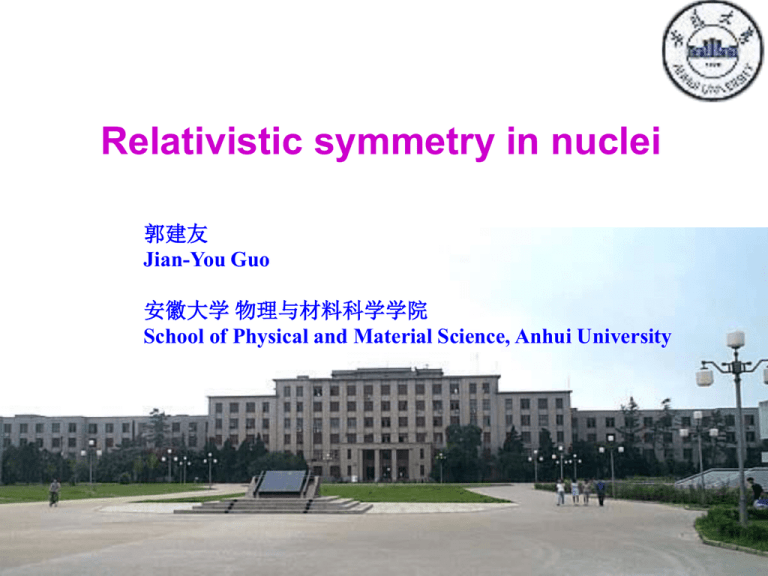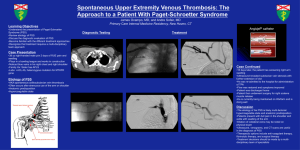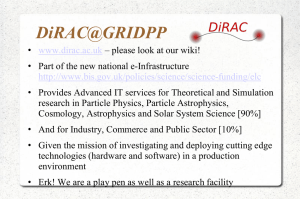赝自旋劈裂减小
advertisement

Relativistic symmetry in nuclei
郭建友
Jian-You Guo
安徽大学 物理与材料科学学院
School of Physical and Material Science, Anhui University
Outline
Discovery of relativistic symmetry
Progress on relativistic symmetry
Our research on relativistic symmetry
New explanation with SRG
Summary and perspective
Discovery of relativistic symmetry
Shell structure in nuclei
\alpha 衰变能量在N=126处突然增加
在N=28, 50, 82, 126 处,中子俘
获截面变得很小
在N=20, 28, 50, 82, 126 处, 原子核
半径改变除以半径改变的平均值随中
子数的变化发生剧烈改变。
核
素
图
Explanation in mean field model
Discovery of pseudospin symmetry(PSS)
赝自旋对称性是1969 年核物理的一个重要发现,它和壳模型在物理上是相通的。从原
子核单粒子能级图上, 可以看到幻数 2,8,20,28,50,82,一直到后面的126。在
1969年,两个研究组 Arima 等人和 Hecht等人分别独立发现了赝自旋对称性。
Arima 等人和Hecht 等人发现, 1d3/2 和2s1/2的能级劈裂非常小, 而且它们的总角动量分别
是3/2和1/2, 相差1,就像一对自旋-轨道伙伴态。如果把1d3/2和2s1/2看成是一对自旋-轨
道伙伴态, 引入赝自旋和赝轨道角动量, 就不需要赝自旋-轨道相互作用。有了这个想法
之后, 其它类似的态就可以以此类推得到赝自旋对称性。我们今天再来看这些工作的时
候, 这里面告诉我们独立的思想比什么都重要。如果Arima等人只是沿着Mayer和Jensen
的思想的话, 他们永远也发现不了赝自旋对称性。此外, 他们都是研究代数模型的, 如果
没有自旋-轨道相互作用, 哈密顿量有很高的对称性, 有了自旋-轨道相互作用后, 对称性
都消失了, 无法解析求解。所以他们一直的想法就是将自旋-轨道相互作用去掉。总结起
来, 第一, 必须要有独立思想, 第二, 科学研究必须要有基本出发点。对他们来说, 一直想
把这个自旋-轨道相互作用去掉, 所以才会注意去观察。同时, 由于有独立思想, 他们没有
按照Mayer 和Jensen 的眼光去做研究, 这应该是科学研究史上一个著名的例子。
There is the pseudospin symmetry in nuclei. Why?
Progress on relativistic symmetry
Early attempts
Relativistic origin
Until 1997, Ginocchio indicated that PSS in nuclei arises from nucleons
moving in a relativistic mean field which has an attractive scalar and
repulsive vector potential nearly equal in magnitude.
Joseph N. Ginocchio, PRL78,436(1997)
Dirac equations:
p V (r ) M S (r ) i i i
1
2M
1
2M
d2
' d 1
'
G (r ) G (r )
2
M
2
2
2M dr
r
r 4M
dr
d2
' d 1
'
F (r ) F (r )
2
M
2
2
2M dr
r
r 4M
dr
where (r ) V (r ) S (r ), (r ) V (r ) S (r )
Thereafter, the PSS has received much attention in
nuclear physics
Other discoveries
PSS in the deformed systems
Pseudospin symmetry in
the Dirac equation with a
deformed potential
Sugawara, Yamaji, and
Arima,PRC62,
054307(2000)
Test of pseudospin
symmetry in deformed
nuclei
Ginocchio,Leviatan,Meng,
and Zhou, PRC 69,
034303 (2004)
PSS in scattering states
The PSS breaking depends on the scattering angle but reaches a
maximum of 10%, whereas the spin breaking reaches a maximum of 22%.
Hence, PSS has validity for medium energy nucleon scattering.
Ginocchio,PRL82,4599(1999)
Ginocchio underestimates the violation of PSS, but the conclusion of a
modestly broken PSS in proton-208Pb scattering at EL=800 MeV remains
valid.
Leeb, PRC62, 024602(2000)
Existence of PSS in proton-nucleus scattering is questionable in the whole
energy region considered and that the violation of this symmetry stems from
the long range nature of the Coulomb interaction
Leeb, PRC69,054608(2004)
PSS in wave function
Ginocchio indicated that physically realistic relativistic mean fields lead to
small PSS breaking which implies that the lower components of the
corresponding Dirac single-nucleon wave functions satisfy
f l (r ) fl 1 (r )
Dirac spinor
l
gn (r )Y jm
( , )
n r
if (r )Y l ( , )
jm
n
Dirac-equation
d 1
V S M dr r g (r )
f (r )
d 1
V S M
r
dr
g (r )
f (r )
Ginocchio,PRC57,1167(1998)
Ginocchio etal.,
derived the wave
functions of the
pseudospin partners
of eigenstates of a
realistic Dirac
Hamiltonian and
found a well
symmetry in these
wave functions
In 2002, Ginocchio
indicated that PSS
imposes conditions on
the Dirac eigenfunctions
independent of the
potentials from triaxial to
spherical potentials. He
have derived the general
conditions on the RMF
eigenfunctions in the
PSS limit.
Ginocchio,PRC66,064312(2002)
Borycki etal, investigate the
effects of pseudospin and
spin symmetry breaking on
the single nucleon wave
functions in spherical nuclei
by using relations between
wave functions obtained in
the framework of the
relativistic mean field theory.
Spin symmetry(SS) in anti-nucleon spectrum
Zhou etal., PRL91,262501(2003)
a) There is a very well developed SS in single antineutron and single
antiproton spectra.
b) The dominant components of the wave functions of the spin doublet are
almost identical.
c) SS in antiparticle spectra and PSS in particle spectra have the same origin
Lisboa etal. Indicated, for nucleons and antinucleons, the SS is of
perturbative nature, almost an exact symmetry in the physical region for
antinucleons. The PSS is of dynamical nature and cannot be viewed in a
perturbative way for either nucleons or antinucleons.
Lisboa etal., PRC81,064324(2010)
PSS exists in
collective states
Xu etal., PRC78,
064301(2008)
Identification of
pseudospin
partner bands in
108Tc
Theoretical explanation
Based on relativistic mean field (RMF) theory
Lagrangian density:
1
L i i M i U ( ) g i i
2
1
1
m2 g i i
4
2
1 1 2
R R m g i i
4
2
1
13
F F e i
A i
4
2
1 2 2 g2 3 g3 4
R
g
U ( ) m
F A A
2
3
4
Equations of motion:
p V (r ) M S (r ) i i i
1 3 0
0
0
A (r )
V ( r ) g ( r ) g 3 ( r ) e
2
S ( r ) g ( r )
U ( ) ( r ) g s ( r )
m
m
2
0
( r ) g v ( r )
2
0
( r ) g 3 ( r )
0 ( r ) e c ( r )
s ( r ) A i ( r ) i ( r )
i 1
( r ) A ( r ) ( r )
i 1 i i
v
A
(
r
)
( r ) 3 i ( r )
3
i 1 i
A
13
i (r )
c ( r ) i 1 i ( r )
2
Based on the RMF theory, Lalazissis etal have investigated the PSS
for spherical and deformed nuclei.
Lalazissis etal., PRC58,R45(1998)
Ginocchio,etal., PLB425,1(1998)
a) The quasidegenerate pseudospin doublets do exist near the Fermi
surface for both spherical and deformed nuclei.
b) The PSS is restored better and better as one moves closer to the
continuum limit.
Based on the relativistic continuum Hartree-Bogoliubov theory, Meng etal.
show that the quality of the PS approximation is connected to the competition
between the PCB and the PSOP.
For the spherical case
Dirac equation
to the form
J.Meng etal., PRC58,R628(1998), PRC59,154(1999)
p V (r ) M S (r ) i i i
Pseudo spin-orbital potential(PSOP)
term
Pseudocentrifugal barrier(PCB)
Pseudospin approximation is good
Based on the relativistic Hartree approximation, Marcos etal. have
studied the contribution of PSOP on PSS.
Marcos etal., PRC62, 54309(2000) ;PLB 513 (2001) 30
a) PSS cannot be only explained in terms of the relative value of the PSOP and
of the PCB, it is also necessary to consider the effect of the nuclear surface
smoothness
b) Scalar meson mass influences on the single-particle energy level ordering of
the pseudospin doublet.
c) PSS is not due to the smallness of the PSOP term in relation with the PCB,
but rather to a cancellation of different contributions to the SPE.
The contribution from the PSOP term to the energy splittings of pseudospin
partners is large. The near pseudospin degeneracy results from a significant
cancellation among the different terms in that equation, manifesting the
dynamical character of this symmetry in the nucleus.
The effect of the Coulomb potential is quite small, the \rho potential gives
the main contribution to the observed isospin asymmetry of the pseudospin
splittings. This asymmetry results from a cancellation of the various energy
terms
Lisboa etal., PRC67, 054305(2003)
The contribution of the isoscalar tensor coupling to the realization of
pseudospin symmetry in nuclei.
The tensor coupling reduces noticeably the pseudospin splittings, especially
for the surface levels.
Albert etal., PRC71, 034313(2005)
Long etal. have investigated the PSS in the density-dependent relativistic
Hartree-Fock theory for the doubly magic nucleus 132Sn.
Long etal., PLB639, 242(2006)
a) They indicate the Fock terms bring significant contributions to the PSOP
and make it comparable to the PCB.
b) The \rho- tensor couplings play a significant role in PSS conservation.
Long etal., PRC81, 31302®(2010)
Explanation of PSS(SS) based on SU(2) symmetry
For spherical system, the Dirac spinors
l
G
(
r
)
Y
gn 1 n
jm ( , )
n r
l
f n r iFn (r )Y jm ( , )
Dirac equation
dGn (r )
dr r Gn (r ) [ M n (r )]Fn (r )
dFn (r ) F (r ) [ M (r )]G (r )
n
n
n
dr
r
where (r ) V (r ) S (r ), (r ) V (r ) S (r )
1
2M
1
2M
d2
' d 1
'
G (r ) G (r )
2
M
2
2
2M dr
r
r 4M
dr
d2
' d 1
'
F (r ) F (r )
2
M
2
2
2M dr
r
r 4M
dr
where 2M M , 2M M
Dirac equation is turned into the Schrödinger-like equation
1
2M
1
2M
d2
' d 1
'
G (r ) G (r )
2
M
2
2
2M dr
r
r 4M
dr
d2
' d 1
'
F (r ) F (r )
2
M
2
2
2M dr
r
r 4M
dr
For the upper spinor equation, the centrifugal barrier (CB) and the
spin-orbital potential (SOP)
VCB
1 1
'
, VSOP
2
2M
r
r 4M 2
For the lower spinor equation, the pseudo-centrifugal barrier (PCB)
and the pseudo spin-orbital potential (PSOP)
1 1
'
VPCB
2M
r
2
, VPSOP
r 4M 2
In analogy with Schrödinger equation,
1 l l 1 ,
1 l l 1
a) l is the orbital angular momentum of the upper component of the Dirac
spinor.
b) l is the orbital angular momentum of the lower component of the Dirac
spinor, Ginocchio, PRL 78, 436 (1997).
c) the condition that S(r) + V(r) = 0 is suggested as the exact PSS limit by
reducing the Dirac equation to the Schrodinger-like equation,
Ginocchio:1997.
c) S(r) + V(r) = Constant can be approximately fulfilled in exotic nuclei with
highly diffuse potentials, Meng:1998,1999.
Perturbative interpretation of relativistic symmetry
Liang, Zhao, Zhang, Meng, GIaI,
PRC83, 041301(R) (2011)
Dirac Hamiltonian is divided into two parts
The realistic system can be
treated as a perturbation of SS
Hamiltonian, but can not be
treated as a perturbation of PSS
Hamiltonian.
The energy splitting of the
pseudospin doublets can be
regarded as a result of small
perturbation around the
Hamiltonian with RHO potentials,
There exist the problems in the present studies
1
2M
1
2M
d2
' d 1
'
G (r ) G (r )
2
M
2
2
2M dr
r
r 4M
dr
d2
' d 1
'
F (r ) F (r )
2
M
2
2
2M dr
r
r 4M
dr
where 2M M , 2M M
a. There exist no bound nuclei within dΣ/dr = 0.
b. M_ = 0 at finite r0 => there exist singularities in VPCB and VPSOP
c. Effective Hamiltonian is not Hermitian => perturbation theory can
not be applied
d. There exists the coupling the energy and the operator
Although the perturbative method removes from the singularities,
a. We can not see the obvious form of operator.
b. The physical meaning of PSS is not clear.
幻灯片 60
Our research on relativistic symmetry
PSS in the relativistic harmonic oscillator
Guo etal, Nuclear Physics
A 757 (2005)
The single-particle
levels in 208Pb with
HO and RMF
Wave functions of pseudospin doublets
Pseudospin energy
splitting with the harmonic
oscillator frequency in
different nodes
Pseudospin wavefunction
splitting with the harmonic
oscillator frequency in
different pseudoorbital
angular momentum.
Pseudospin energy
splitting with r0 in
different nodes
Pseudospin wavefunction
splitting with r0 in different
pseudoorbital angular
momentum.
Pseudospin
wavefunction splitting
with the harmonic
oscillator frequency
Pseudospin
wavefunction splitting
with r0
Research on the contributions from different fields of
mesons and photons to PSS
Guo etal, Eur. Phys. J. A
45 (2010)
Sun etal., Eur. Phys. J. A
48 (2012)
p V (r ) M S (r ) i i i
1 3 0
0
0
A (r )
V ( r ) g ( r ) g 3 ( r ) e
2
S ( r ) g ( r )
By introducing the transformation
g g
For spherical nuclei
the σ-field
The PS energy splitting with the
strength of the ω-field
For deformed nuclei
Sun etal., Eur. Phys. J. A 48 (2012)
PSS in the resonant states
ACCC
approach
1977年, Kukulin 等提出处理多粒子体系共振态的ACCC方法
V. I. Kukulin etal., J. Phys. A 10,33(1977)
V. I. Kukulin etal., Sov. J. Nucl. Phys. 29, 421(1979)
V. I. Kukulin, Theory of Resonances (Kluwer Academic,Dordrecht,1989)
S.C.Yang, J.Meng, S.G.Zhou ,CPL18 196(2001)
S.S. Zhang, J.Y.Guo, S.Q.Zhang, J.Meng, CPL21, 632
(2004)
S.S.Zhang, J.Meng, et al, PRC70, 034308 (2004).
J.Y.Guo, R.D.Wang, X.Z.Fang, PRC72, 054319(2005)
J.Y.Guo and X.Z.Fang, PRC74, 024320 (2006)
S.S.Zhang,E.G.Zhao,S.G.Zhou, (2011)
Theoretical study of the two-proton halo candidate 17Ne including
contributions from a resonant continuum and pairing correlations
ACCC
+RMF approach
Equations of motion:
p V (r ) M S (r ) i i i
1 3 0
0
0
A (r )
V ( r ) g ( r ) g 3 ( r ) e
2
S ( r ) g ( r )
U ( ) ( r ) g s ( r )
2
0
m
( r ) g v ( r )
2
0
m
( r ) g 3 ( r )
0
( r ) e c ( r )
s ( r ) A i ( r ) i ( r )
i 1
( r ) A ( r ) ( r )
i 1 i i
v
A
(
r
)
( r ) 3 i ( r )
3
i 1 i
A
13
i (r )
c ( r ) i 1 i ( r )
2
对于束缚态, 自洽迭代求解上述耦合方程可得能谱和波函数等
对于共振态, 利用 ACCC 方法确定共振态的能量和宽度
1
即令: S (r) λ S (r)
H T V
H T V
1
V(r)
λ= 1
r
Padé逼近
λ0 1
V0
用 Padé II 近似展开波数:
2
L
c
c
x
c
x
c
x
[ L, N ]
2
L
k ( x) k
( x) i 0 1
2
N
1 d1 x d 2 x d N x
0 - 支点
k k
L, N
1 0
k m E i
2
2
共振能量
宽度
2
k (0 ) 0
20
U (r )
U0
1 exp (r R) / a
}
0
2g 9/2
1i 11/2
3p 1/2
3p 3/2
2f 5/2
1i 13/2
}
Energy [MeV]
The single-particle levels in
208Pb calculated by the ACCC
method in the Dirac equation
for a Woods-Saxon potential
with the parameters R = 7fm,
Δ0 = 650.0MeV, Σ0 = -66MeV,
and a = 0.6fm.
2f 7/2
1h 9/2
3s 1/2
1h 11/2
2d 3/2
2d 5/2
}
-20
1g 7/2
1g 9/2
2p 1/2
2p 3/2
1f 5/2
1f 7/2
-40
1k 15/2
2i 11/2
2i 13/2
3g 9/2
2h 9/2
1j 13/2
2h 11/2
3f 7/2
2g 7/2
3d 5/2
2s 1/2
1d 3/2
1d 5/2
1p 1/2
1p 3/2
Guo etal, PRC72, 054319
(2005)
(r)
1s 1/2
-60
0
2
4
6
r [fm]
8
10
Pseudospin energy splitting [MeV]
赝自旋能级劈裂与表面弥散度a的变化关系
Alberto etal, PRC65,034307 (2002)
6
E(3d5/2)-E(2g7/2)
E(3f7/2)-E(2h9/2)
E(2h11/2)-E(1j13/2)
E(3g9/2)-E(2i11/2)
E(2i13/2)-E(1k15/2)
4
2
0
-2
-4
-6
Pseudospin width splitting [MeV]
0.4
0.5
0.6
a [fm]
E(3d5/2)-E(2g7/2)
E(2h11/2)-E(1j13/2)
25
20
0.7
0.8
E(3f7/2)-E(2h9/2)
E(3g9/2)-E(2i11/2)
E(2i13/2)-E(1k15/2)
15
10
5
0
0.4
0.5
0.6
a [fm]
0.7
0.8
1)从 a=0.4fm 开始,随 a 增加,赝自旋能
量劈裂减小,进一步增加 a,出现能级返
转,能量劈裂变大,与束缚态情况一致。
2)对于宽度,随 a 增加,赝自旋劈裂一致
性减小, 没有出现返转,位于高角度量的
共振态具有较长的寿命。
3) 能量相同的赝自旋伙伴,宽度可能不同,
实验上探测共振态需要考虑这种情况。
赝自旋能级劈裂与表面半径 R 的变化关系
Pseudospin energy splitting [MeV]
Alberto etal, PRC65,034307 (2002)
4
2
0
E(3d5/2)-E(2g7/2)
E(3f7/2)-E(2h9/2)
E(2h11/2)-E(1j13/2)
E(3g9/2)-E(2i11/2)
E(2i13/2)-E(1k15/2)
-2
-4
-6
6.5
7.0
7.5
8.0
Pseudospin width splitting [MeV]
R [fm]
E(3d5/2)-E(2g7/2)
E(3f7/2)-E(2h9/2)
E(2h11/2)-E(1j13/2)
E(3g9/2)-E(2i11/2)
E(2i13/2)-E(1k15/2)
25
20
15
10
5
0
6.5
7.0
7.5
R [fm]
8.0
1)从R=6.5fm 开始,随R增加,赝自旋能量劈裂
减小,进一步增加R,出现能级返转,能量劈裂
变大,与束缚态情况一致。
2)对于宽度,随 R 增加,赝自旋劈裂减小, 没
有出现返转,位于高角度量的共振态具有较长
的寿命。
3) 能量相同的赝自旋伙伴,宽度可能不同,实
验上探测共振态需要考虑这种情况。
4)出现了一个能量劈裂异常的赝自旋伙伴,但
宽度劈裂没有出现异常。
Pseudospin energy splitting [MeV]
赝自旋能级劈裂与势阱深度 U0 的变化关系
2
E(3d5/2)-E(2g7/2)
E(3f7/2)-E(2h9/2)
E(2h11/2)-E(1j13/2)
E(3g9/2)-E(2i11/2)
E(2i13/2)-E(1k15/2)
1
0
Alberto etal, PRC65,034307 (2002)
-1
-2
-3
-4
-5
-70
-68
-66
-64
-62
Pseudospin width splitting [MeV]
[MeV]
E(3d5/2)-E(2g7/2),
E(2h11/2)-E(1j13/2),
E(2i13/2)-E(1k15/2)
25
20
E(3f7/2)-E(2h9/2)
E(3g9/2)-E(2i11/2)
1) 随|∑0|减小,赝自旋能量劈裂增加,
与束缚态情况一致。
2)对于宽度,随|∑0|减小,赝自旋劈裂
也增加 。
3)出现了一个能量劈裂异常的赝自旋伙
伴,但宽度劈裂没有出现异常。
15
10
5
0
-70
-68
-66
[MeV]
-64
-62
Isospin dependence of PSS in nuclear resonant states
Guo etal, PRC 74, 024320 (2006)
20
1j13/2
Single particle energy [MeV]
10
}
0
}
}
-10
1g9/2
2p1/2
2p3/2
1f5/2
1f7/2
-20
-30
2s1/2
1d3/2
1d5/2
-40
2h9/2
1j15/2
2h11/2
1i11/2
3f5/2
3f7/2
2g7/2
2g9/2
3d3/2
3d5/2
1i13/2
3p1/2
2f5/2
3p3/2
1h9/2
2f7/2
1h11/2
3s1/2
2d3/2
2d5/2
1g7/2
Sn()
110
130
150
170
Mass number
30
20
10
0
3f7/2
2h9/2
3d3/2
3d5/2
2h11/2
2g7/2
1j13/2
2g9/2
{
1i11/2
1j15/2
2f5/2
1i13/2
1h9/2
2f7/2
{
{
110
130
150
170
Mass number
1s1/2
-60
40
Sn()
3f5/2
50
90
1p1/2
1p3/2
-50
在 RMF-ACCC方法中, 自洽迭代求解平均
场, rstep= 0.05fm, rbox= 20fm, 相互作用:
NL3,以 Sn 同位素为例
Single particle width [MeV]
190
1) 除几个kink, 随质量数增加, 共振态能量
下降,和阈附近的束缚能级一致。
2) 共振态的能量和宽度出现交叉。
3) 出现kink的位置和束缚态相似。
4) 出现能隙现象,存在壳结构。
8
E(3d5/2)-E(2g7/2)
E(3f7/2)-E(2h9/2)
E(2g9/2)-E(1i11/2)
E(2h11/2)-E(1j13/2)
E(2s1/2)-E(1d3/2)
E(2p3/2)-E(1f5/2)
E(2d5/2)-E(1g7/2)
E(2f7/2)-E(1h9/2)
6
4
2
0
-2
-4
-6
Pseudospin width splitting [MeV]
Pseudospin energy splitting [MeV]
The energy and width splittings of pseudospin doublets as a function of mass
number for the Sn isotopes. The filled and opened marks denote the cases of bound
and resonant states, respectively.
25
E(3d5/2)-E(2g7/2)[r]
E(3f7/2)-E(2h9/2)[r]
E(2g9/2)-E(1i11/2)[r]
E(2h11/2)-E(1j13/2)[r]
20
15
10
5
0
-8
110
120
130
140
Mass number
150
160
170
100
110
120
130
140
150
160
170
Mass number
1) 赝自旋劈裂与单粒子态量子数有关,不同的赝自旋双重态,赝自旋劈裂不同,
与束缚态情况一致。
2) 随质量数增加,赝自旋劈裂减小(除3f7/2,2g9/2外),中子丰核具有更好的赝
自旋对称性一致。
3) 对于径向量子数相同的赝自旋伙伴,随轨道量子数的增加,共振态的赝自旋
劈裂出现了返转现象。
4) 与Dirac-ACCC结果类似,出现了3f7/2,2g9/2赝自旋劈裂异常情况。
E(1p1/2)-E(1p3/2)
E(1d3/2)-E(1d5/2)
E(1f5/2)-E(1f7/2)
E(1g7/2)-E(1g9/2)
10
E(2f5/2)-E(2f7/2)
E(2g7/2)-E(2g9/2)
E(1h9/2)-E(1h11/2)
E(1i11/2)-E(1i13/2)
8
6
4
4
Spin width splitting [MeV]
Spin energy splitting [MeV]
The energy and width splittings of spin-orbit doublets as the function of mass number
for the Sn isotopes. The filled and opened marks represent the cases of bound and
resonant states, respectively.
E(2f5/2)-E(2f7/2)[br]
E(2g7/2)-E(2g9/2)[r]
E(1h9/2)-E(1h11/2)[br]
E(1i11/2)-E(1i13/2)[r]
3
2
1
2
0
0
100
110
120
130
140
150
160
170
110
120
130
140
150
160
Mass number
Mass number
1)自旋轨道劈裂与单粒子态量子数有关,不同的自旋双重态,自旋轨道劈裂不同,
与束缚态情况一致。
2) 随质量数增加,自旋轨道劈裂减小,中子丰核具有更好的自旋对称性。
3) 共振态的自旋轨道劈裂没有出现返转现象。
4) 对于径向量子数相同的自旋伙伴,随轨道量子数的减小,自旋对称性越好。
170
Pseudospin energy splitting [MeV]
The energy splittings between doublets as a function of mass number in the Sn
isotopes for proton pseudospin partners (2d5/2, 1g7/2), (2f7/2, 1h9/2), and (2g9/2,
1i11/2) with the corresponding neutron ones for comparison. The filled and opened
marks denote the cases of bound and resonant states, respectively.
6
E(2d5/2)-E(1g7/2)
E(2f7/2)-E(1h9/2)
E(2g9/2)-E(1i11/2)
4
Guo etal, PRC 74,
024320 (2006)
P
2
N
0
P
N
-2
P
N
-4
-6
110
120
130
140
150
160
170
Mass number
质子单粒子共振态的赝自旋劈裂与中子情况相似。
Relativistic effect of spin and pseudospin symmetries
Guo etal.,
PRC (submitted)
the atomic units ћ = m = 1 are adopted instead of the conventional
relativistic units ћ = c = 1 in the present system.
where the Compton wavelength λ = ћ /mc = 1/c. In this units, the result in
the nonrelativistic limit can be obtained in a very simple, intuitive, and
straightforward manner by taking the speed of light c ∞ or the Compton
wavelength λ 0, which is not possible in the latter units since c = 1
The spin energy splitting
ΔE = En,l-1/2 - En,l+1/2
The PS energy splitting
ΔE = En,Ĩ-1/2 - En,Ĩ+1/2
The upper components of
Dirac spinors for the spin
doublets 1g7/2 and 1g9/2
The lower components of
Dirac spinors for the
pseudospin doublets 2g9/2
and 1i11/2
New explanation with SRG
幻灯片 35
The diagonalized Dirac operator
Remarks:
The operator for Dirac particle
The operator for Dirac anti-particle
a) For the Dirac particle, the
spin symmetry is exact
when Δ’ = 0
b) For the Dirac antiparticle,
the spin symmetry is
exact when Σ’ = 0.
c) The singularity
disappears in every
component
d) The operators H1 and H2
are Hermitian.
e) There is no the coupling
between the energy ϵ
and the operator H1 (H2).
In order to compare with the exact solution, the energy spectrum of H1 with
Woods-Saxon potential.
The energy spectrum of H1 for the six pseudospin partners. The first column
in each subfigure indicates that H1 is approximated to the non-relativistic
limit. The second and third columns in each subfigure indicate that H1 is
approximated to the orders 1/M2 and 1/M3, respectively. The fourth column
in each subfigure indicates the exact relativistic spectra.
In order to disclose the origin of PSS, we check the contribution of
every component in H1 to the pseudospin energy splitting. Based on
the considerations of attribute and Hermitian, we decompose H1 into
the eight components as follows:
The energy of every component
k represents the single particle states: 1s1/2, 2s1/2, and etc
The pseudospin energy splittings are calculated:
Remarks:
a) 动力学的贡献有增加PS劈裂,有
减小PS劈裂,两项的贡献是同向
的
b) 自旋轨道的贡献减小PS劈裂
c) 随 R 增加,动力学贡献出现反转,
两项的反转位置几乎一致
Remarks:
a) 非相对论的 PS 劈裂很大,说明
PSS 是相对论的
b) 非相对论的PS劈裂随弥散参数 a
的增加而减小
c) 动力学和自旋轨道引起的 PS 劈裂
随 a 的变化不明显
d) 费米面附近的能级,动力学贡献
出现了反转,也减小PS劈裂
Remarks:
a) 随势阱深度的减小,相对论的PS
劈裂减小,费米面附近的能级减
小更明显
b) 自旋轨道引起的PS劈裂随 ∑0 的变
化不明显
c) 费米面附近, 动力学引起的PS劈裂
随 ∑0 的变化明显, 且改善PSS
Remarks:
a) 随势阱宽度R的增加,相对论的
PS 劈裂变化十分显著
b) 动力学和自旋轨道引起的 PS 劈裂
随 R 的变化也很明显,
c) 非相对论的 PS 劈裂随弥散参数 R
的增加变化不大
d) 费米面附近,动力学的 PS 劈裂随
R 的增加发生反转
The energy
spectrum of H2 for
Dirac antiparticle.
800
M-reV
a) 反核子谱拥有PS
b) 自旋轨道劈裂是非常
小的
900
700
600
500
400
Antiparticle
300
0
Conclusion
•
•
•
•
2
4
r [fm]
6
8
10
PSS is a relativistic symmetry, non-relativistic PS splitting is large
The quality of PSS is linked to the shape with the parameters
The dynamic terms and spin-orbit coupling contribution to the PSS
PSS is the equilibrium of contributions from the shape of potential,
dynamic terms and spin-orbit coupling.
• PS in anti-nucleon is better than PSS in nucleon
Summary and perspective
Summary
The discovery of PSS is introduced
Some explanation on PSS is sketched
A new explanation on PSS is presented
Perspective
The origin of PSS ?
A Hamiltonian operator with PSS ?
The new observables possessing PSS ?
Thank you!
Dirac equation (local potentials, no tensor potential, spherical symmetry)
r M
d
dr r
d
G (r )
dr r G (r )
F
r
F
r
r M
where (r ) V (r ) S (r ), (r ) V (r ) S (r )
1
2M
1
2M
d2
' d 1
'
G (r ) G (r )
2
M
2
2
2M dr
r
r 4M
dr
d2
' d 1
'
F (r ) F (r )
2
M
2
2
2M dr
r
r 4M
dr









